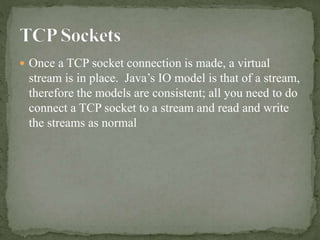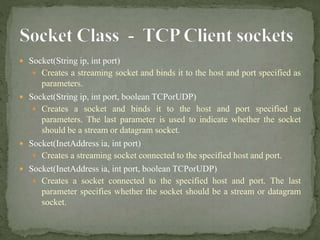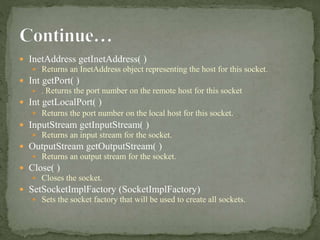Java networking basics & sockets overview
- 1. B.Kohila M.Sc(info.tech), Nadar Saraswathi College of arts and science, Theni
- 2. The Inetaddress class provides you with a limited interface to DNS for doing both forward and reverse internet address lookups - An InetAddress class method corresponds to a DNS request Npublic constructoro
- 3. Three static methods: InetAddress getByName(String) Static method used to retrieve the address for the host name passed as the parameter. InetAddress [ ] getAllByName(String) Static method used to retrieve all the addresses for the host name passed as a parameter. InetAddress getLocalHost( ) Static method used to retrieve the address for the current, or local, host.
- 4. Three additional “getter” methods String getHostName( ) Returns the host name. byte[ ] getAddress( ) Returns the IP address. String getHostAddress( ) Returns the IP address as a string.
- 5. try { InetAddress fullname = netAddress.getByName(“bigyellowcat.cs.binghamton.edu"); InetAddress alias = InetAddress.getByName(“bigyellowcat"); InetAddress octets = InetAddress.getByName(“128.226.121.44"); if (fullname.equals(alias) && fullname.equals(octets)) // All is right with the world!} catch (UnknownHostException e) { // Exception handling here. }
- 6. Once a TCP socket connection is made, a virtual stream is in place. Java’s IO model is that of a stream, therefore the models are consistent; all you need to do connect a TCP socket to a stream and read and write the streams as normal
- 7. Socket(String ip, int port) Creates a streaming socket and binds it to the host and port specified as parameters. Socket(String ip, int port, boolean TCPorUDP) Creates a socket and binds it to the host and port specified as parameters. The last parameter is used to indicate whether the socket should be a stream or datagram socket. Socket(InetAddress ia, int port) Creates a streaming socket connected to the specified host and port. Socket(InetAddress ia, int port, boolean TCPorUDP) Creates a socket connected to the specified host and port. The last parameter specifies whether the socket should be a stream or datagram socket.
- 8. InetAddress getInetAddress( ) Returns an InetAddress object representing the host for this socket. Int getPort( ) . Returns the port number on the remote host for this socket Int getLocalPort( ) Returns the port number on the local host for this socket. InputStream getInputStream( ) Returns an input stream for the socket. OutputStream getOutputStream( ) Returns an output stream for the socket. Close( ) Closes the socket. SetSocketImplFactory (SocketImplFactory) Sets the socket factory that will be used to create all sockets.
- 9. try { Socket socket = new Socket("somehost.somewhere.com", -1); // Always a good idea to buffer the stream to mitigate blocking. PrintStream out = new PrintStream( new BufferedOutputStream(socket.getOutputStream())); out.println("Are you listening?"); DataInputStream in = new DataInputStream( new BufferedInputStream(socket.getInputStream())); in.readLine(); // ... // Don't forget to close the socket! socket.close() } catch (Exception e) // Exception handling logic.
- 10. Since UDP is a connectionless protocol; there is no virtual stream between the hosts so streams are not used for IO. UDP applications are not thought of in terms of clients and servers, but rather in terms of senders and receivers. For conversational applications both ends (sender and receiver) will be changing states from sender to receiver and back again Many UDP based applications are simple send a request then receive the data (sender’s perspective), like a DNS request. The receiver’s perspective is to ‘listen’ for a request, send the response, listen for more requests.
- 11. UDP sockets send and receive Datagrams Constructors: two for receiving, four for sending DatagramPacket( byte[ ] buff , int len) Constructs a DatagramPacket for receiving packets of length len. DatagramPacket(byte[] buf, int off, int len) Constructs a DatagramPacket for receiving packets of length len, specifying an offset of off bytes into the buffer. DatagramPacket((byte[] buf, int len, InetAddress addr, int port) Constructs a datagram packet for sending packets of length len to the specified port number on the specified host. DatagramPacker(byte[] buf, int off, int len, InetAddress addr, int port) Constructs a datagram packet for sending packets of length len with offset off to the specified port number on the specified host. DatagramPacket(byte[] buf, int off, int len, SocketAddress addr) Constructs a datagram packet for sending packets of length len with offset off to the specified port number on the specified host.
- 12. Constructors DatagramSocket() Constructs a datagram socket and binds it to any available port on the local host. DatagramSocket(DatagramSocketImpl impl) Creates an unbound datagram socket with the specified DatagramSocketImpl. DatagramSocket(int port) Constructs a datagram socket and binds it to the specified port on the local host. DatagramSocket(int port, InetAddress iaddr) Creates a datagram socket, bound to the specified local address. DatagramSocket(SocketAddress bindaddr) Creates a datagram socket, bound to the specified local socket address.


![ Three static methods:
InetAddress getByName(String)
Static method used to retrieve the address for the host name passed
as the parameter.
InetAddress [ ] getAllByName(String)
Static method used to retrieve all the addresses for the host name
passed as a parameter.
InetAddress getLocalHost( )
Static method used to retrieve the address for the current, or local,
host.](https://image.slidesharecdn.com/javanetworkingbasessocketsoverview1-200125050400/85/Java-networking-basics-sockets-overview-3-320.jpg)
![ Three additional “getter” methods
String getHostName( )
Returns the host name.
byte[ ] getAddress( )
Returns the IP address.
String getHostAddress( )
Returns the IP address as a string.](https://image.slidesharecdn.com/javanetworkingbasessocketsoverview1-200125050400/85/Java-networking-basics-sockets-overview-4-320.jpg)






![ UDP sockets send and receive Datagrams
Constructors: two for receiving, four for sending
DatagramPacket( byte[ ] buff , int len)
Constructs a DatagramPacket for receiving packets of length len.
DatagramPacket(byte[] buf, int off, int len)
Constructs a DatagramPacket for receiving packets of length len,
specifying an offset of off bytes into the buffer.
DatagramPacket((byte[] buf, int len, InetAddress addr, int port)
Constructs a datagram packet for sending packets of length len to the
specified port number on the specified host.
DatagramPacker(byte[] buf, int off, int len, InetAddress addr, int port)
Constructs a datagram packet for sending packets of length len with
offset off to the specified port number on the specified host.
DatagramPacket(byte[] buf, int off, int len, SocketAddress addr)
Constructs a datagram packet for sending packets of length len with
offset off to the specified port number on the specified host.](https://image.slidesharecdn.com/javanetworkingbasessocketsoverview1-200125050400/85/Java-networking-basics-sockets-overview-11-320.jpg)
